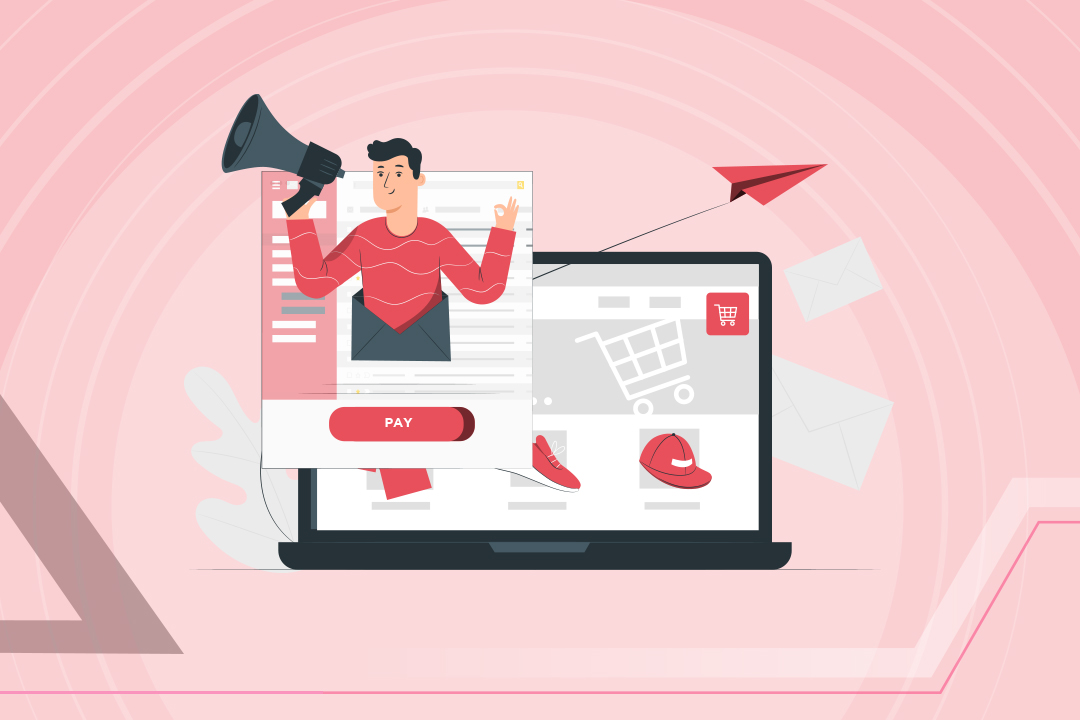Cart abandonment is one of the most critical issues in the eCommerce industry. It refers to the scenario where visitors add products or services to the cart but drop them off mid-way before completing the purchase. Due to cart abandonments, according to a Forrester research via Dynamic yield, every year eCommerce stores lose approximately $18 billion in sales. Roughly 60-80% of online shopping carts are abandoned mid-way before the visitors complete the purchase. While it may not be possible to recover all the abandoned carts, there are certainly ways to reduce them. In this blog, we’ll cover how you can reduce and recover abandonments with the help of abandoned cart emails. We’ll cover the templates for cart abandonment emails, with 17 examples, their key takeaways and 9 tips for creating a killer abandoned cart recovery email.
Content Index
- What is a cart abandonment recovery email?
- How do abandoned cart emails help eCommerce stores?
- How to segment users for cart abandonment emails
- 17 cart abandonment email examples with their key takeaways
- 9 Tips to create abandonment cart email that boosts revenue
- Conclusion
- FAQs
What is a cart abandonment recovery email?
Abandoned cart emails or abandoned cart recovery emails are a series of auto-reminders sent to visitors who didn’t finish the purchase. These are emails that can be triggered based on the action (checked coupon code) or inaction (didn’t complete purchase in 10 minutes post adding products to the cart) of the visitor. Sending cart abandonment recovery emails at the right time to the right user can be a very effective way to recover lost sales opportunities.
How do abandoned cart emails help eCommerce stores?
It’s remarkably effective as a sales recovery tactic and boosting revenue. According to Omnisend’s eCommerce email statistics, cart recovery emails have a 40.1% open rate, and a 9% click-through rate resulting in 69% more sales when multiple emails are sent in an automated manner instead of a one-off email.
How to segment users for cart abandonment emails
Another critical aspect of the cart abandonment recovery email is segmenting the users. Spray and pray email techniques should be avoided to increase the effectiveness of your email campaigns. Decisions on the time to send, number of emails to send, which incentive to use, how much discount to offer etc should be taken based on the user segmentation. You may segment users in the following ways when sending cart recovery emails:
Based on the user status
- New
- Returning
- Active buyers
- Recent abandoners
Based on cart size
- Small
- Medium
- Large
Based on the cart value
- High value
- Low value
- Product Type
17 cart abandonment email examples with their key takeaways
Let’s take a look at some of the cart abandonment emails that stand out from the rest.
# 1 Reminder email
Sometimes customers abandon their carts by mistake or get caught up in some other important task during the purchase. A reminder email is helpful in such scenarios to remind the customer of the product they added to the cart before dropping it off and nudging them to complete the order.
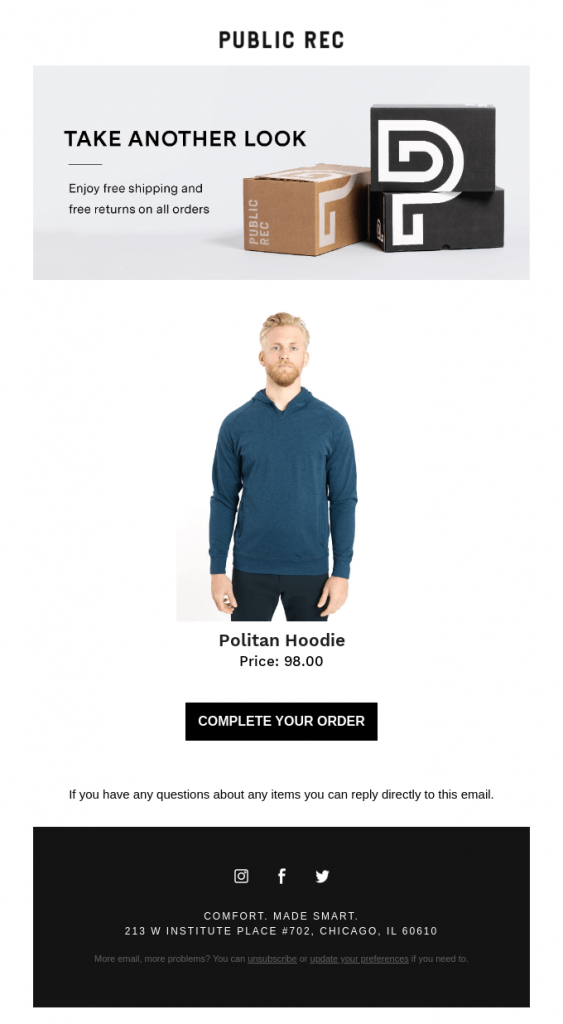
# 2 Reinstating trust
Potential customers sometimes may drop off due to a lack of trust in the brand or the payment process. Even well-known brands like Dyson use emails to reinstate the trust factor by highlighting the reasons to shop with them and reassuring the customer-friendly policies.
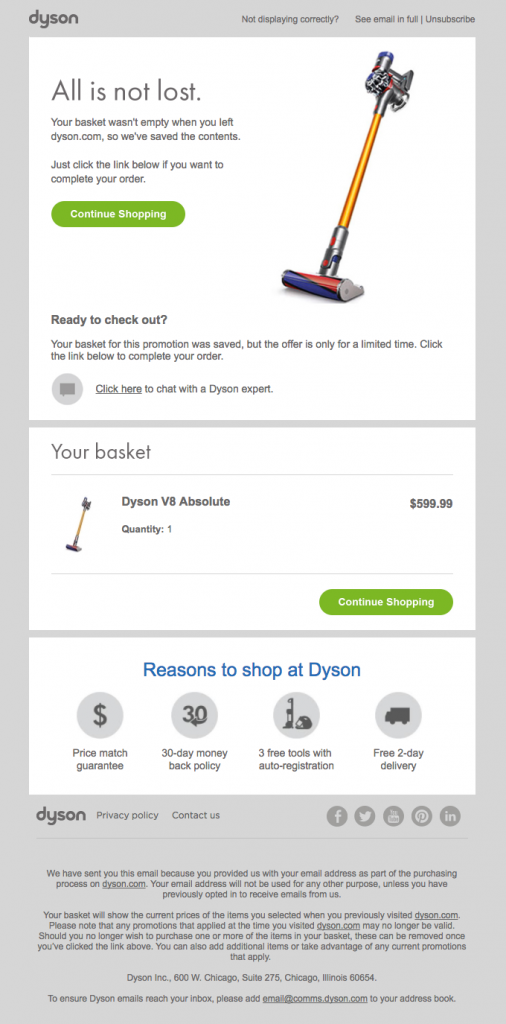
# 3 To the point
Some customers prefer a direct email with the details of the crucial pointers nicely packed in it. Below is one such example which contains important information about the cart like the item, amount, and CTA button along with the contact email and phone number of the eCommerce site.
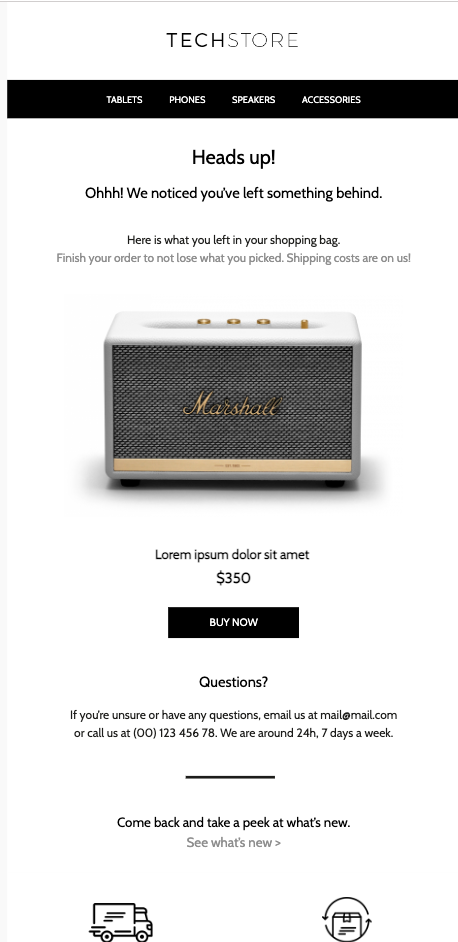
# 4 Customer feedback
Sometimes, customers may be genuinely not able to finish the purchase due to some issues with the flow. By triggering the cart abandonment email promptly along with giving the contact information upfront you can make it easy for the customer to complete the purchase or share their feedback on the checkout process.
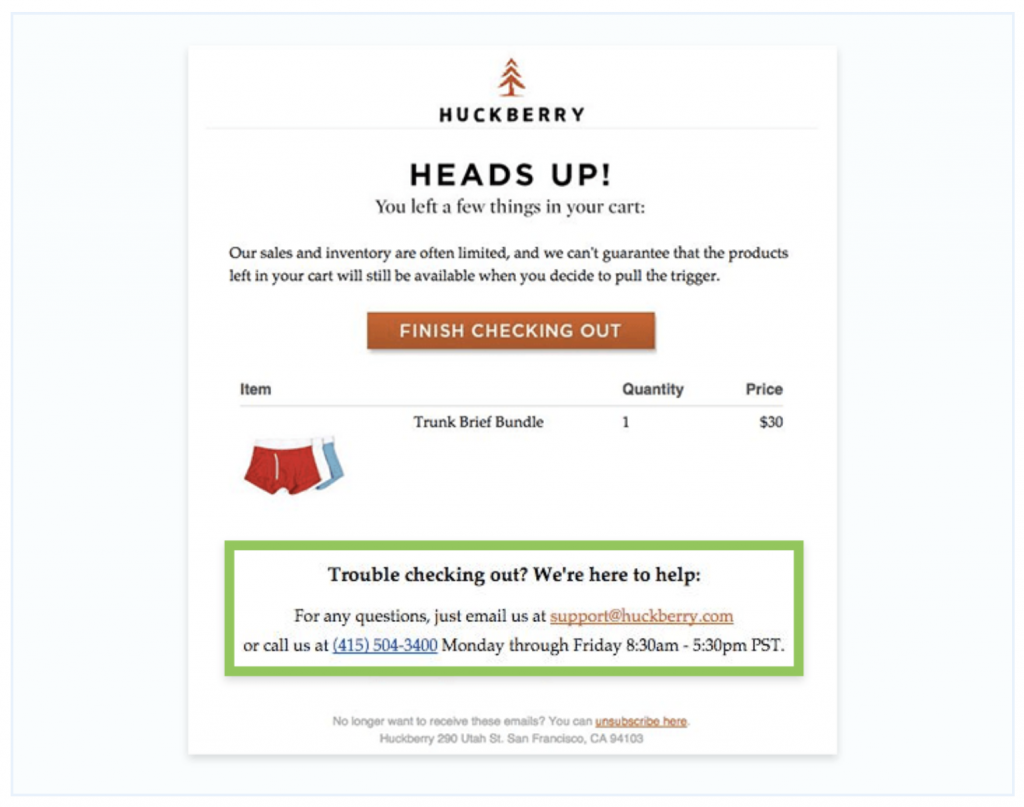
# 5 Clever copy and visual
Buyers are unlikely to remember all the items they may have added to their cart. A playful copy and visual if it goes well with the brand can help you to win back a lost sale opportunity. The use of the word bubble above the abandoned cart item joking about feeling abandoned is an eye-catcher for sure.
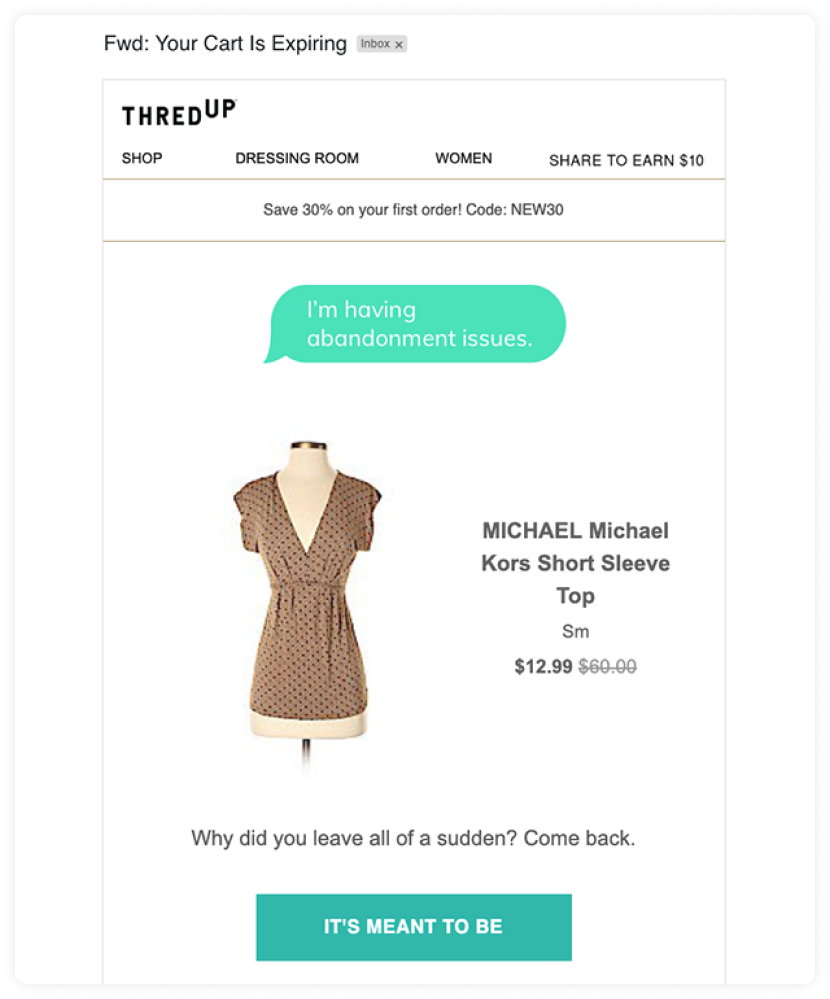
# 6 Persona-based copy
Persuasive copy tailored-made for the persona you are targeting can go a long way in getting your conversions up with abandoned cart emails. Here is one such example where the brand understands the persona very well and tailors the copy with all the terms a dog owner would surely relate to.
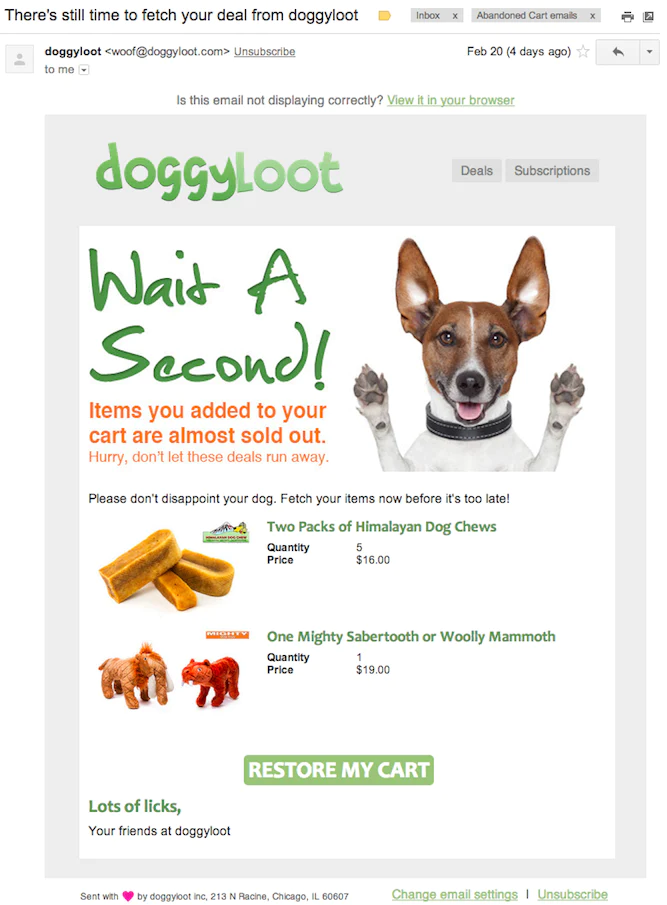
# 7 Urgency in the copy
With great copy, you can deliver an urgent message to your customers in an effective way. In this example, Google uses texts like: Our popular items sell out fast, (almost) gone to communicate that the product may not be available if the buyer doesn’t take immediate action.
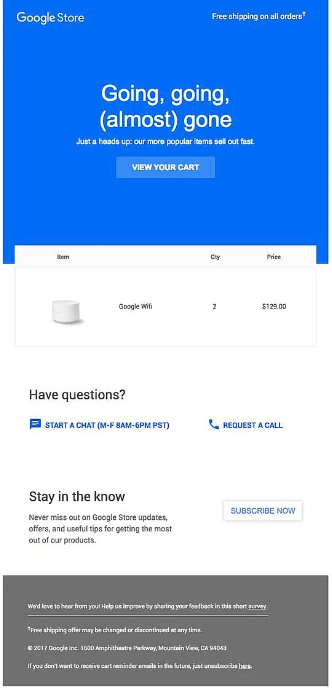
# 8 Smart copy
Today’s shoppers are well aware. They know that leaving the cart mid-way will result in a series of cart abandonment emails. Glossier addresses this upfront and incorporates it funnily in their email. It is short, attention-grabbing and amusing.
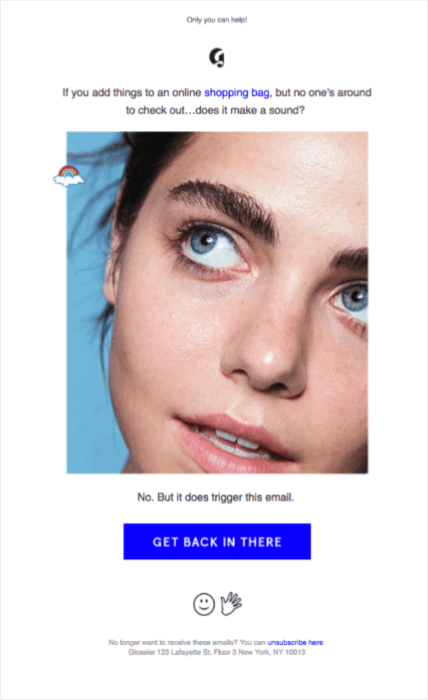
# 9 Interactive amp
Interactive shopping emails i.e. shopping carts within the email are a new fast-growing way to reduce cart abandonments. Here, transactions are completed within the email instead of the browser redirections using AMP for email. With lower distractions and no redirections, these kinds of emails may lead to higher conversions.
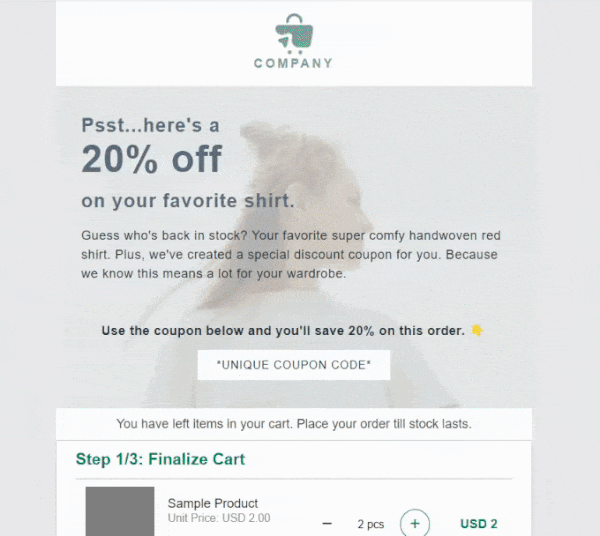
# 10 Product image
Dollar shave club uses product imagery to get back potential customers to the shopping cart. Along with the product image it uses quick bullet pointers along with a clear CTA to invoke the action by the user.
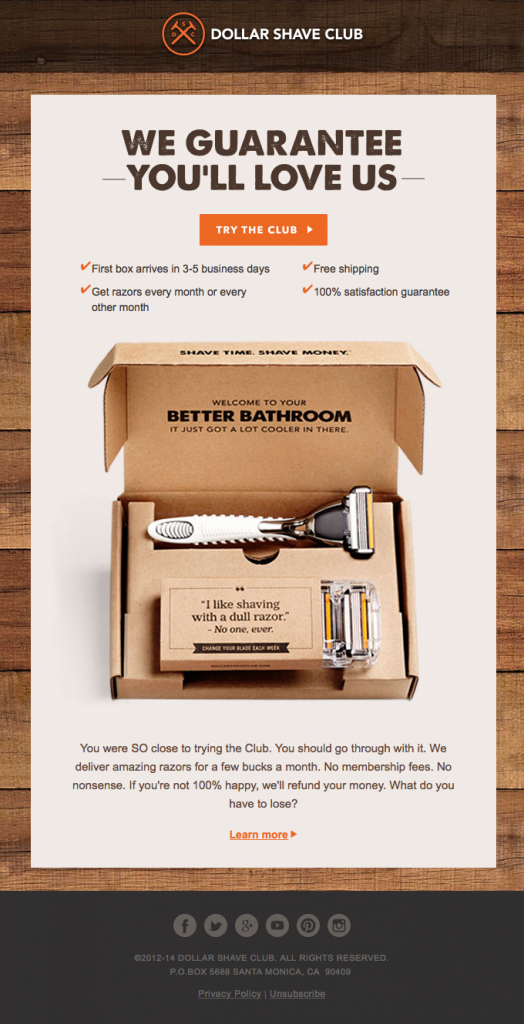
# 11 Related categories
Dotbo uses recommendations to lure back the buyer. Along with the item added to the cart, it also recommends other categories that the buyer may be interested in. It uses a good combination of images, CTA, discounts and a referral campaign.

# 12 Wishlist abandonments
Potential customers are not always in-market i.e looking to buy right away. Sometimes they just window shop and keep adding items to their wishlist or buy later list. It is useful to track these purchase intent signals too and target the customers with your bestsellers along with the products they wanted to buy in the first place.

# 13 Alternative suggestion
Offering alternatives to the items added to the cart can be a great way to lure back potential customers. With the ‘you might also like’ category, you can quickly show them the other options they have in terms of colour, pattern, popular seller, lower priced items etc. All these without overwhelming them with replacements for the original item.
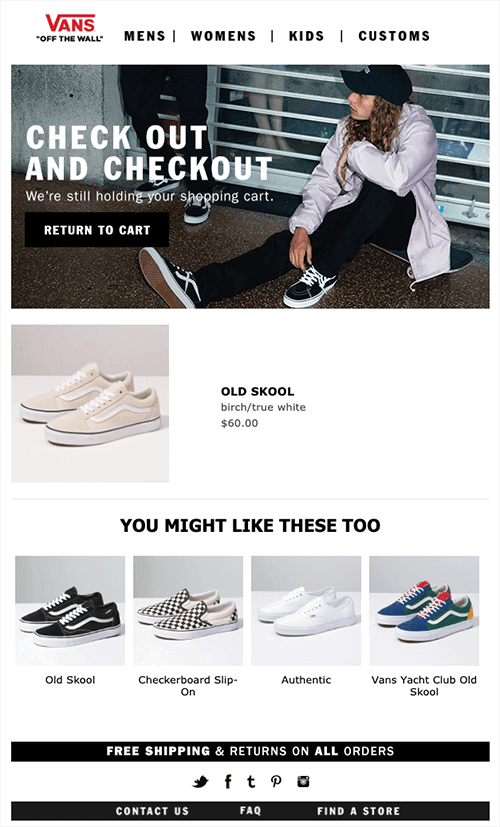
# 14 Time-bound deals
Offering a deal at the right moment can potentially get you more sales. In this email by Nomad, the email does multiple things in the right manner. The deal is lucrative, contextual, time-bound and personalised along with a satisfaction guarantee as the trust indicator.
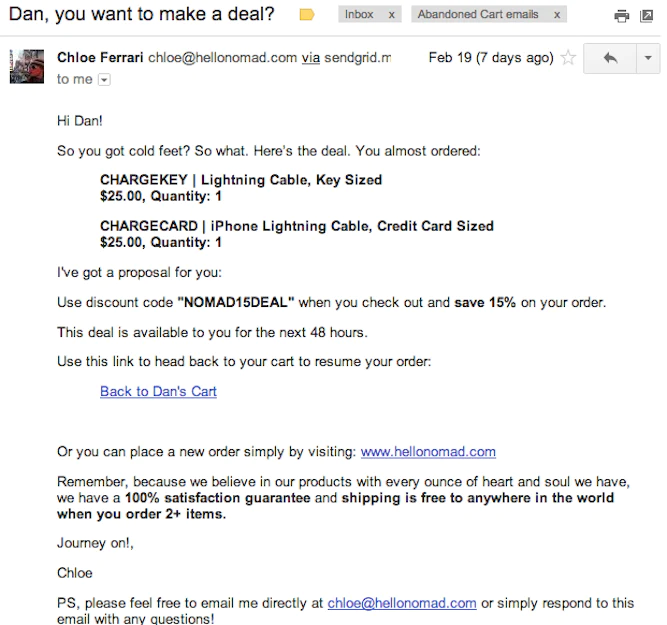
# 15 Coupon at the right moment
Discounts and coupons can be a double-edged sword. They can be used as a last resort after other emails have failed to get the required action. At the same time, you would not want your potential customers to think that the product is not worth the price.
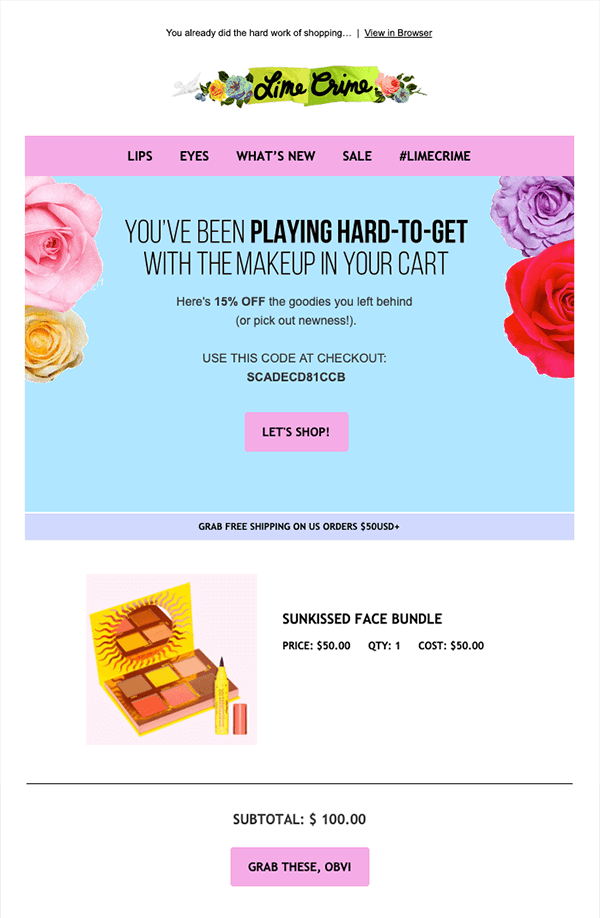
# 16 Dynamic codes
A generic email coupon code can sometimes leak into the public domain. This can cannibalise sales that would anyway happen without the code. You can avoid this situation with a dynamic coupon code which can be only used once by the intended user.
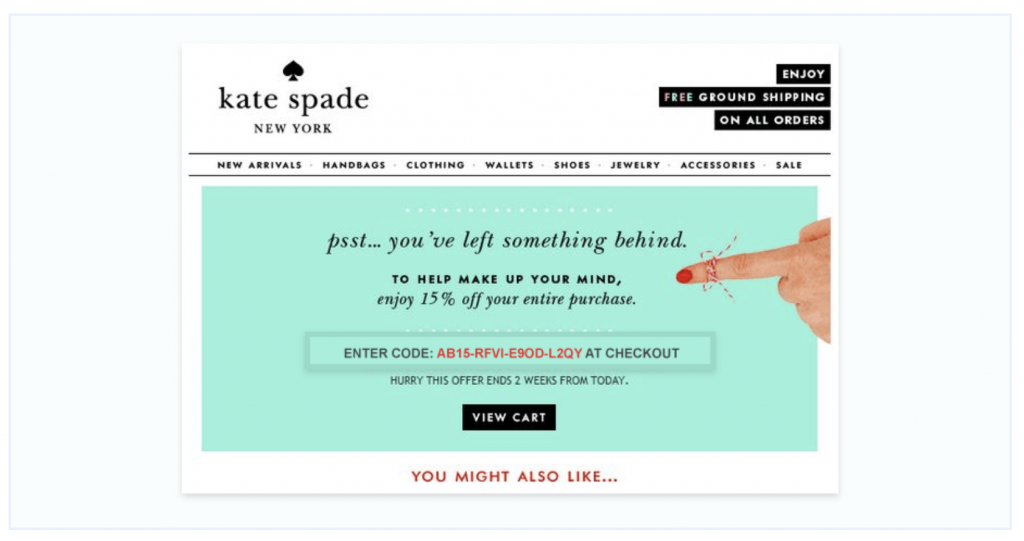
# 17 Price drop alert
Potential customers are sensitive and receptive to price. Sending a pricing drop alert can be a good way to get the excitement up around the products added to the cart. This can be further enhanced with other recommendations and special campaigns that may be running then.
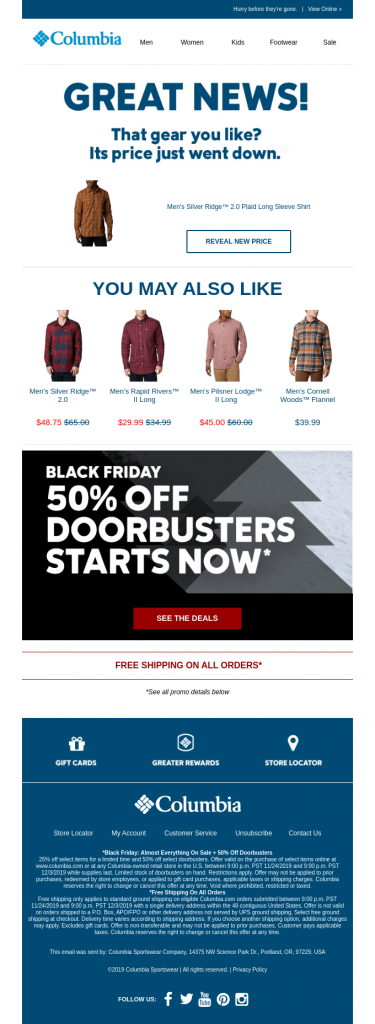
9 tips to create abandoned cart email that boosts revenue
Now that you’ve seen the top examples of cart abandonment emails let’s understand the critical elements required to create a cart abandonment email.
1. Contextual and personalised
The email should have details about the cart items, what the customer may miss out on, and offers or discounts if any.
2. Timely
Test to figure out when is the best time to send the first cart abandonment email. It could range from minutes to a few hours depending on the industry and use case.
3. Powerful copy and visual
These two elements are literally the backbone of your cart abandonment emails. A persuasive, concise and compelling copy along with a powerful visual can nudge users to complete the purchase.
4. Subject line
Although the subject line is outside the email, it is the most critical element to get users to open and read the email. Humour, questions, and discounts are some of the most used subject lines.
5. Strong CTA
Your emails should provoke action. A Call to Action (CTA) button should easily enable users to take that action. It could be specific like Buy Now / Shop Now or creative like Go show your cart some love.
6. Create urgency
Have a limited stock? Prices are going to go up? Do you have an ongoing discount campaign running? Let your potential customers know these clearly in the abandonment email series.
7. Provide alternatives and bestsellers
What are others buying? What are the other options? These are questions shoppers may have. Use your emails to answer these common questions and convert more window shoppers into paying customers.
8. Discounts and coupons
Customers may be put off seeing that the final cart price is more than the expected amount. Incentivising genuine customers at the right time can boost sales because who doesn’t want a discount?
9. Series instead of a single email
Cart abandonment emails work best when deployed in an automated manner with multiple emails instead of a one-off email. Use a combination of different messaging and tactics to see what works best for your business.
Conclusion
It’s your turn for the action. Now that you know the important aspects of cart abandonment emails, it’s time you start shooting the emails and boosting your revenue. Employ the above 17 templates and the 9 tips in your cart abandonment emails and let us know the results. Testing is the best way to figure out what is the best approach for your customers, the one that boosts your sales.
FAQs
Yes, retailers across the world have seen the advantages of sending abandoned cart emails. It increases the revenue by helping in recovering lost sales opportunities.
The number of emails may depend on the product type, user status, cart value and cart size. According to Omnisend, a sequence of three emails is 69% more effective than a single email.
As per Forrester, eCommerce businesses lose approximately $18 billion in sales due to cart abandonments. Through abandoned cart emails, businesses try to get more sales by offering contextual information to the visitors helping them to complete the purchase.
The copy, visual, length and call to action may vary depending on the product type, user status, cart value and cart size. As per experts, a crisp, contextual, personalised and timely email performs better than generic and lengthy emails.
As per reports, roughly 60-80% of online shopping carts are left mid-way before the visitors complete the purchase. This behaviour of leaving the cart mid-purchase is known as an abandoned basket.
Some of the popular ways to handle cart abandonments are email marketing, retargeting ads, push notifications and phone calls to visitors to understand the reasons behind the abandonment.

